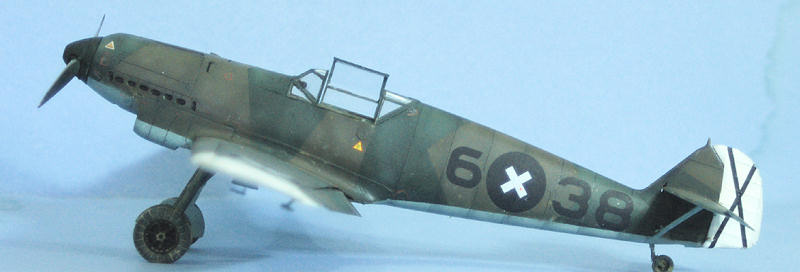
Eduard 1/32 Bf-109B (conversion)
| KIT #: | 3401 |
| PRICE: | $39.95 MSRP |
| DECALS: | One option |
| REVIEWER: | Tom Cleaver |
| NOTES: |
Alley Cat Bf-109B
conversion: 32009C, MSRP: 22.50 Pounds, Decals for Three
aircraft |

| HISTORY |
Messerschmitt began work in 1933 on a four‑passenger light “sporting
aircraft” of cantilever low‑wing monoplane
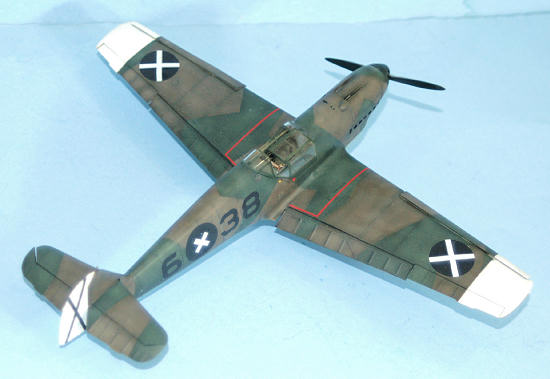 design, with retractable landing
gear. The BFW M.37 was completed in
the spring of 1934. Later
redesignated Bf‑108 Taifun ("Typhoon"), it was entered in the fourth
Challenge de Tourisme Internationale. While it did not win any of the
events, its performance impressed the Reichluftfartministerium
sufficiently to earned the Bf-108 a production contract.
design, with retractable landing
gear. The BFW M.37 was completed in
the spring of 1934. Later
redesignated Bf‑108 Taifun ("Typhoon"), it was entered in the fourth
Challenge de Tourisme Internationale. While it did not win any of the
events, its performance impressed the Reichluftfartministerium
sufficiently to earned the Bf-108 a production contract.
Before the Bf‑108 had made its first flight, Messerschmitt learned the
RLM was about to issue a new specification for a modern fighter, to be powered
by the Junkers Jumo 210 and to be capable of at least 280 mph. Officially, most
German aircraft manufacturers were invited to submit designs; unofficially, only
Arado, Heinkel, Fieseler or Focke Wulf could expect serious consideration.
Erhard Milch, who hated Willi Messerschmitt and had done everything he
could to destroy Messerschmitt's business, did not even inform the company of
the competition. However, unknown
to Milch, Hermann Göring, had sent a confidential
message to Messerschmitt, ordering him to develop "a lighting‑fast courier plane
which needs only to be a single‑seater." It was obvious to Messerschmitt that
Göring wanted to see him produce a fighter.
The design team at BFW's Augsburg factory - Robert Lusser, Richard Bauer
and Hubert Bauer ‑ commenced the design of a single-seater that would
incorporate the Bf‑108's features: a monoplane with retractable landing gear,
enclosed cockpit, leading‑edge slots and trailing‑edge flaps.
 The Bf‑109V1 was rolled out on
The Bf‑109V1 was rolled out on
Luftwaffe pilots were at first afraid of the airplane, and the
thoroughly-pedestrian Heinkel He-112, with a low landing speed and an open
cockpit, appeared to be the winner until Ernst Udet flew the Bf-109V2 and
declared it superior to all others in the competition. Ten pre-production
Bf‑109B‑0s were ordered in the summer of 1936, followed shortly by two events
that would affect the Bf‑109's fate.
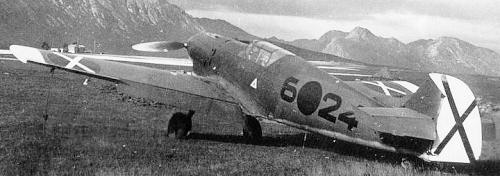 In June 1936, the same month that the Bf-109 entered pre-production, the
Royal Air Force announced production contracts for 600 Hawker Hurricane fighters
and 310 Supermarine Spitfires. The threat posed by those new British fighters
added urgency to
In June 1936, the same month that the Bf-109 entered pre-production, the
Royal Air Force announced production contracts for 600 Hawker Hurricane fighters
and 310 Supermarine Spitfires. The threat posed by those new British fighters
added urgency to
The other major event was the revolt of conservative elements under
General Francisco Franco y Bahamonde against the Republican government of
That November, Luftwaffe volunteers were assigned to the Condor Legion to
fight for Franco's Nationalists. At
about the same time, the Soviet Union sent aircraft and pilots to aid the
Spanish Republic, including the Polikarpov I‑15 biplane and the I‑16, the
world's first low‑wing monoplane fighter with retractable landing gear and an
enclosed canopy. Both Soviet
fighters completely outclassed the Condor Legion's Heinkel He‑51 biplanes.
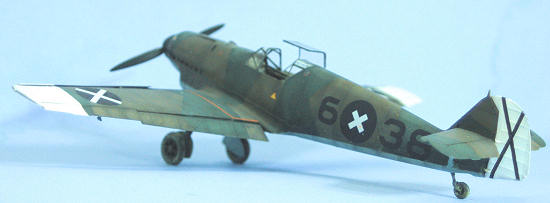 As a result, the Luftwaffe rushed the Bf‑109V‑4 to
As a result, the Luftwaffe rushed the Bf‑109V‑4 to
The Condor Legion's first operational unit to fly the Bf-109, 2.
Staffel of Jagdgruppe 88 (2.J/88) commanded by
Oberleutnant Günther Lützow, began receiving the new Bf-109s in
March, 1937. The unit was
initially plagued by accidents, but the pilots soon met the challenge of taking
off and landing on a narrow‑track undercarriage in an airplane that tended to
drop its left wing, applying plenty of compensation with the rudder. 2.J/88
commenced operations over the Brunete salient on July 10, 1937.
The Bf‑109B and its principal rival, the I‑16, were closely matched. The
Bf‑109B was faster in level flight and in a dive, while the I‑16 had a superior
climb rate and maneuverability. Republican ace Andres Garcia Lacalle stated in
his memoirs that the I‑16 was superior up to 3,000 meters (9,840 feet), but from
that altitude upward, the Bf‑109B's performance was superior to that of the
I‑16.
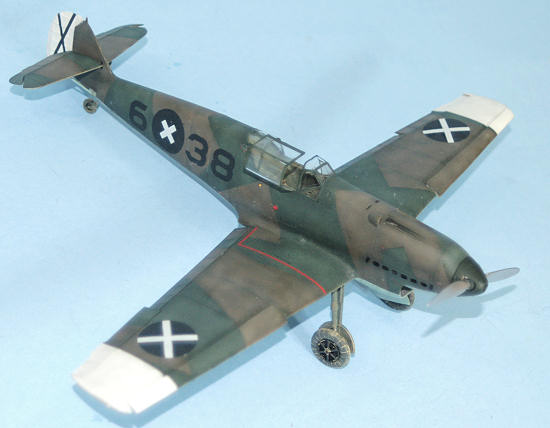 The Bf-109B drew first blood on
The Bf-109B drew first blood on
Perhaps the outstanding Luftwaffe pilot to fly in the Spanish Civil War
was Oberleutnant Werner Mölders, who arrived in
Guided by lessons learned in
| THE KIT |
Eduard's Bf-109E-1 “Weekend Kit” is the earlier Bf-109E-1 first released
in 2008, minus the photo-etch, and with only one decal option.
The kit retails for approximately half the price of the “Profipack”
version.
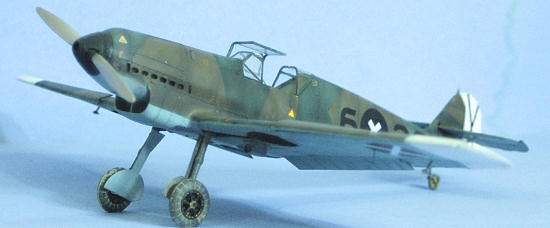
| CONSTRUCTION |
The conversion is designed to replace the cowling, prop, wing slats,
flaps, and underwing radiators of the Eduard kit.
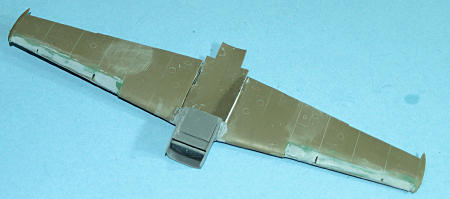
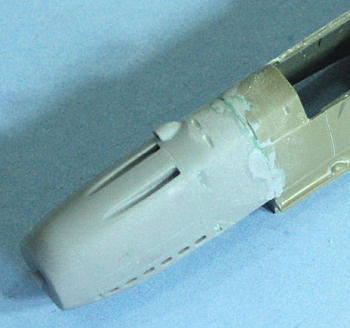
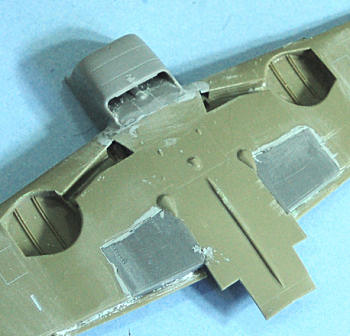
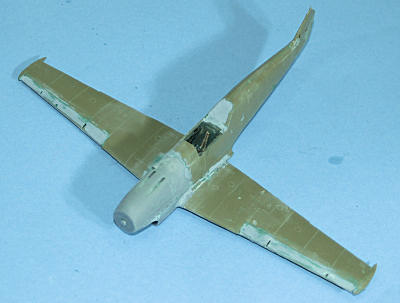 ockpit
and added a set of photo-etch seatbelts.
Since the kit does not have the photoetch instrument panel, I did mine
with an instrument panel decal from the decal dungeon.
ockpit
and added a set of photo-etch seatbelts.
Since the kit does not have the photoetch instrument panel, I did mine
with an instrument panel decal from the decal dungeon.
| COLORS & MARKINGS |
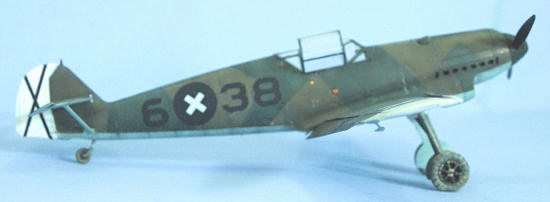 This is
wrong. The first Bf-109Bs - of
which 6-o-39 is one, were supplied by the Luftwaffe in the standard
70/71/65 factory scheme. This paint
faded badly during the operations over Brunete in the summer of 1937, to the
point that by that fall they could have been mistaken for airplanes painted in
62/63/65. That winter, they were in
fact repainted in overall RLM 63, which was more appropriate to the Spanish
environment. I am indebted to “Mr. Bf-109,” Lynn Ritger, for providing me a
photo of 6-o-39, which clearly identifies it as being in the darker scheme of
70/71/65. I decided to do a very
faded scheme, using Tamiya “Dark Green,” “Black Green” and “Light Blue”, and
doing the “hard-edge” scheme by masking with drafting tape.
This is
wrong. The first Bf-109Bs - of
which 6-o-39 is one, were supplied by the Luftwaffe in the standard
70/71/65 factory scheme. This paint
faded badly during the operations over Brunete in the summer of 1937, to the
point that by that fall they could have been mistaken for airplanes painted in
62/63/65. That winter, they were in
fact repainted in overall RLM 63, which was more appropriate to the Spanish
environment. I am indebted to “Mr. Bf-109,” Lynn Ritger, for providing me a
photo of 6-o-39, which clearly identifies it as being in the darker scheme of
70/71/65. I decided to do a very
faded scheme, using Tamiya “Dark Green,” “Black Green” and “Light Blue”, and
doing the “hard-edge” scheme by masking with drafting tape.
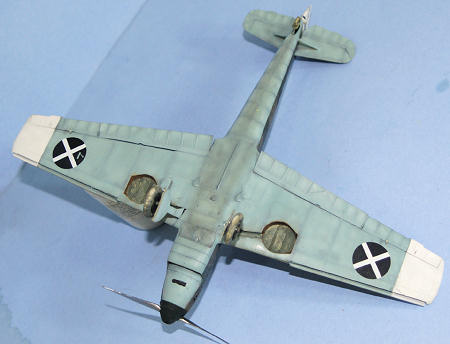 hese
painted areas so that the end result was not so “Extreme Spanish School” in its
look. I then masked these areas in
the standard pre-war camouflage pattern, and applied the RLM 70 “Black Green,”
which was then faded using Tamiya “Deep Green” with progressive applications of
light grey, followed by thinning it as I had the other color, and adding in a
brushful of white, to tone down those areas.
The spinner was painted with Black-Green and left unfaded, since this
airplane would have been originally equipped with a wooden prop, with the
controllable prop upgraded toward the end of the summer of 1937.
hese
painted areas so that the end result was not so “Extreme Spanish School” in its
look. I then masked these areas in
the standard pre-war camouflage pattern, and applied the RLM 70 “Black Green,”
which was then faded using Tamiya “Deep Green” with progressive applications of
light grey, followed by thinning it as I had the other color, and adding in a
brushful of white, to tone down those areas.
The spinner was painted with Black-Green and left unfaded, since this
airplane would have been originally equipped with a wooden prop, with the
controllable prop upgraded toward the end of the summer of 1937.
| FINAL CONSTRUCTION |
I first applied exhaust stains and gunshire stains with Tamiya “Smoke,”
then “dinged” the kit at various places to show wear.
I shortened the oleos of the landing gear 1/16 inch, since the Eduard kit
comes with the gear legs at maximum extension.
I then attached the landing gear and prop, and aileron mass balances, and
set the canopy in the open position.
| CONCLUSIONS |

Review Kit courtesy of my wallet. Bf-109B conversion courtesy of Alley Cat Productions. Get yours at www.a2zeemodels.co.uk
If you would like your product reviewed fairly and quickly, please contact me or see other details in the Note to Contributors.